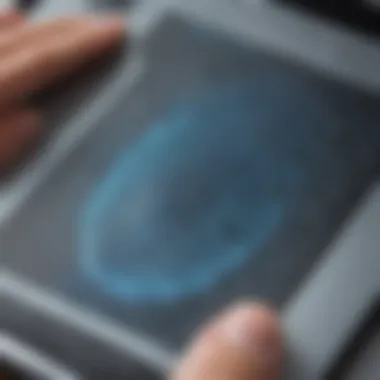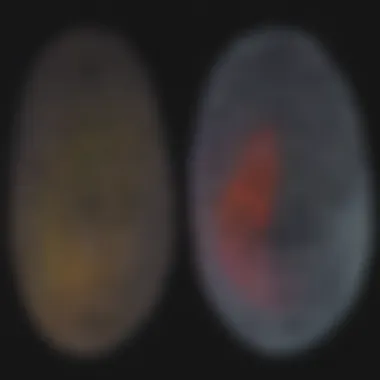Unraveling the Enigmatic World of Fingerprint Forensics: A Comprehensive Exploration


Science Fun Facts
Want to unlock the mysteries of fingerprints? Let's delve into the captivating world of fingerprint forensics where every print tells a story. From ancient civilizations using fingerprints as signatures to modern crime-solving techniques, this unique identifier has played a crucial role in investigations.
Discover the Wonders of Science
In this journey of discovery, we will unravel how each fingerprint is like a tiny, intricate puzzle piece. Explore how forensic experts match patterns to identify individuals, like detectives solving a complex mystery. Witness the evolution of fingerprint analysis from manual ink methods to high-tech digital databases.
Science Quiz Time
Test your knowledge with these brain-teasing questions: How are fingerprints formed? Can identical twins have the same fingerprints? What makes fingerprints so unique? Challenge yourself to think like a forensic scientist cracking cases with just a touch.
Science Experiment Showcase
Get hands-on with a fun experiment: Create your fingerprints using ink and paper to see the patterns up close. Follow safety tips while enjoying this interactive activity. Imagine you're a forensic investigator studying prints under a magnifying glass, just like in the movies.
Introduction to Fingerprint Forensics
Fingerprint forensics stands as a pillar of modern investigative processes, delving into the unique traits that set individuals apart. By tracing the historical evolution of fingerprint analysis, we unravel the intricate web spanning ancient civilizations to contemporary legal systems. This exploration sheds light on the fundamental principles underpinning fingerprint identification and the remarkable significance it holds in criminal investigations today.
Historical Evolution of Fingerprint Analysis
Influence of Ancient Civilizations on Early Identification Techniques:
In ancient epochs, civilizations crafted rudimentary identification methods based on distinct traits like fingerprints. These early techniques laid the groundwork for modern forensic science, illustrating the enduring appeal of fingerprint analysis in solving mysteries. The unique aspect of ancient methods lies in their simplicity yet effectiveness, showcasing a timeless affinity for detail in identifying individuals. Despite their basic nature, these techniques pioneered a path towards precision in identification, paving the way for sophisticated forensic practices.
Development of Classification Systems in the 19th Century:
The 19th century witnessed a monumental leap in fingerprint analysis with the development of classification systems. This breakthrough revolutionized forensic investigations by categorizing fingerprints into distinct patterns, marking a defining moment in fingerprint identification. The key characteristic of these systems lies in their systematic approach to cataloging fingerprints, streamlining the identification process with logical categorization. A unique feature of these systems includes their adaptability to diverse fingerprint patterns, showcasing the versatility necessary for comprehensive identification in forensic analysis.
Landmark Cases Highlighting the Importance of Fingerprint Evidence:


Landmark cases throughout history have underscored the pivotal role of fingerprint evidence in solving complex crimes. These cases have showcased the unequivocal reliability of fingerprints as valuable forensic evidence, shaping legal precedents and defining the standards for fingerprint admissibility. The key characteristic highlighted in these cases is the irrefutable uniqueness of fingerprints, proving to be a definitive identifier in criminal investigations. A unique feature of such cases is their enduring impact on legal proceedings, reinforcing the indisputable value of fingerprint evidence in the pursuit of justice.
Fundamental Principles of Fingerprint Identification
Distinctive Characteristics of Fingerprints:
Fingerprints boast distinctive characteristics that set them apart as unparalleled identifiers in forensic science. The intricate patterns and ridges unique to each individual offer a wealth of information for forensic experts, serving as a precise marker for identification. The key characteristic of fingerprint distinctiveness lies in its non-replicability, ensuring unparalleled accuracy in personal identification. A unique feature of these characteristics is their permanence throughout one's lifetime, creating a reliable foundation for forensic investigations.
Types of Ridge Patterns and Minutiae Points:
Ridge patterns and minutiae points play a pivotal role in fingerprint identification, offering intricate details that distinguish one print from another. These patterns, including loops, whorls, and arches, provide the basis for classifying fingerprints with precision, enhancing the efficiency of identification processes. The key characteristic of these patterns lies in their variability, allowing for a nuanced classification system that accommodates the diversity of fingerprint structures. A unique feature of ridge patterns and minutiae points is their granular detail, enabling forensic experts to pinpoint individualized traits for accurate identification.
The ACE- Methodology in Fingerprint Examination:
The ACE-V methodology serves as a standardized approach to fingerprint examination, encompassing Analysis, Comparison, Evaluation, and Verification stages. This methodological framework ensures a systematic and thorough examination of fingerprints, prioritizing accuracy and reliability in forensic analysis. The key characteristic of the ACE-V methodology is its exhaustive nature, encompassing multiple stages to validate fingerprint identifications. A unique feature of this methodology is its emphasis on verification, ensuring the veracity of findings through meticulous review and scrutiny.
Legal Admissibility of Fingerprint Evidence
Precedents Setting Standards for Fingerprint Admissibility:
Legal precedents have set stringent standards for the admissibility of fingerprint evidence in court proceedings, highlighting the reliability and validity of fingerprints as forensic evidence. These precedents have solidified the acceptance of fingerprints as a relevant and compelling form of identification in legal contexts, shaping the foundation for fingerprint admissibility. The key characteristic emphasized in these precedents is the uniformity in recognizing fingerprints as probative evidence with high evidentiary value. A unique feature of these standards is their adaptability to evolving forensic technologies, ensuring the continued relevance of fingerprint evidence in legal proceedings.
Challenges and Controversies in Fingerprint Analysis:
Despite its unquestionable value, fingerprint analysis faces challenges and controversies in the realm of forensic science. These issues range from concerns about error rates to challenges in the interpretation of complex fingerprint patterns, posing significant hurdles to forensic experts. The key characteristic of these challenges lies in the nuanced nature of fingerprint analysis, requiring expertise and precision to navigate potential pitfalls. A unique feature of these controversies is their role in shaping advancements in fingerprint technology, fostering innovation and improvement in forensic practices.
Expert Testimony and Courtroom Presentation of Fingerprint Findings:
Expert testimony plays a crucial role in presenting fingerprint findings in court, elucidating the significance of forensic evidence to legal decision-makers. The expert's testimony not only showcases the expertise and authority in fingerprint analysis but also demystifies complex forensic processes for jury comprehension. The key characteristic of expert testimony lies in its persuasive power, guiding the courtroom through the intricacies of fingerprint identification with clarity and confidence. A unique feature of expert testimony is its ability to bridge the gap between forensic science and legal proceedings, providing a contextual understanding of fingerprint evidence for judicial review.
Technological Advancements in Fingerprint Analysis
Exploring the realm of Technological Advancements in Fingerprint Analysis is crucial in unraveling the mysteries behind fingerprint forensics. In this section, we delve into how advancements in technology have revolutionized the way fingerprints are analyzed, providing law enforcement agencies with powerful tools for crime-solving and criminal identification.


Automated Fingerprint Identification Systems (AFIS)
Biometric Applications in Law Enforcement
Taking a closer look at Biometric Applications in Law Enforcement sheds light on how fingerprints play a pivotal role in identifying suspects and solving crimes. By integrating biometric data into law enforcement practices, authorities can swiftly match fingerprints found at crime scenes with those in databases, aiding in the apprehension of perpetrators.
Enhanced Matching Algorithms and Database Integration
Enhanced Matching Algorithms and Database Integration have significantly increased the efficiency and accuracy of fingerprint analysis. By leveraging sophisticated algorithms and seamless database integration, forensic experts can quickly compare and match fingerprints, facilitating prompt and precise criminal identifications.
Efficiency and Accuracy Improvements in Fingerprint Matching
Efficiency and Accuracy Improvements in Fingerprint Matching have streamlined the identification process, leading to quicker resolution of cases. The enhanced speed and precision in matching fingerprints have reduced the margin of errors, ensuring reliable forensic conclusions that stand up to rigorous scrutiny.
Emerging Technologies in Fingerprint Forensics
Exploring Emerging Technologies in Fingerprint Forensics unveils cutting-edge methods that complement traditional fingerprint analysis techniques. These innovations, such as Advances in Latent Fingerprint Development, 3D Imaging, and DNA Analysis, offer forensic experts additional tools to extract valuable evidence from crime scenes.
Advances in Latent Fingerprint Development
The developments in Latent Fingerprint Development have revolutionized the recovery of latent prints from various surfaces. By harnessing advanced techniques, forensic scientists can now extract identifiable prints from challenging surfaces, expanding the scope of fingerprint evidence in investigations.
3D Imaging and Reconstruction Techniques
3D Imaging and Reconstruction Techniques enable forensic experts to visualize and analyze fingerprints in three dimensions. This technological advancement provides a more detailed and accurate representation of fingerprint ridge patterns, enhancing the precision of identifications and bolstering the evidentiary value of fingerprints in court proceedings.
DNA Analysis Complementing Fingerprint Identification
The integration of DNA Analysis with Fingerprint Identification creates a robust forensic toolkit to link individuals to crime scenes. By combining DNA profiles with fingerprint evidence, investigators can establish a more comprehensive understanding of suspects and victims, strengthening the forensic narrative presented in legal contexts.
Challenges and Ethical Considerations in Fingerprint Technology
Navigating the Challenges and Ethical Considerations in Fingerprint Technology is imperative to address the implications of technological advancements in forensic practices. From concerns surrounding Privacy in Biometric Data Storage to addressing Bias and Error Rates, forensic experts must navigate ethical dilemmas to ensure the integrity and accountability of their findings.


Privacy Concerns in Biometric Data Storage
Highlighting Privacy Concerns in Biometric Data Storage underscores the importance of safeguarding sensitive biometric information. As biometric databases grow, maintaining strict privacy protocols becomes essential to protect individuals' identities and prevent unauthorized usage or breaches of confidential data.
Accuracy and Reliability Issues in Automated Systems
Addressing Accuracy and Reliability Issues in Automated Systems is pivotal to uphold the trustworthiness of fingerprint evidence. As reliance on automated systems increases, ensuring consistent accuracy and reliability in fingerprint matching processes is critical to avoid potential miscarriages of justice and false identifications.
Mitigating Bias and Error Rates in Fingerprint Analysis
Efforts to Mitigate Bias and Error Rates in Fingerprint Analysis are essential to maintain the integrity and objectivity of forensic examinations. By implementing transparent practices and continuous training regimes, forensic professionals can minimize the risk of biases and errors, enhancing the credibility and valid interpretation of fingerprint evidence.
Future Directions in Fingerprint Forensics
Fingerprint forensics is a field that constantly evolves, paving the way for Future Directions in Fingerprint Forensics. This facet of the article sheds light on the groundbreaking advancements shaping the future of fingerprint analysis. Exploring the innovative pathways in this domain allows for a glimpse into the forthcoming trends and methodologies crucial for modern investigative processes. Future Directions in Fingerprint Forensics provides a roadmap for integrating cutting-edge technologies and forensic science principles into the fabric of criminal investigations, ensuring efficiency, accuracy, and ethical practices in the field.
Innovations in Forensic Science Integration
Interdisciplinary Approaches to Crime Scene Investigation: Within the realm of Fingerprint Forensics, Interdisciplinary Approaches to Crime Scene Investigation play a pivotal role. This approach amalgamates diverse expertise from various fields such as biology, chemistry, and technology to comprehensively analyze crime scenes. By integrating different disciplines, investigators gain a holistic understanding of the evidence, leading to more informed conclusions and breakthroughs in solving complex cases. Despite its strengths, balancing multiple viewpoints and methodologies can pose challenges in maintaining coordination and communication among specialists.
Integration of Biometrics in National Security Protocols: The Integration of Biometrics in National Security Protocols ushers in a new era of security measures leveraging fingerprint technology. By incorporating biometric data into national security strategies, authorities can enhance identification processes and bolster surveillance systems. This inclusion serves as a powerful tool in safeguarding against potential threats and streamlining security protocols. However, concerns regarding data privacy and potential misuse highlight the delicate balance required to implement such systems effectively.
Collaborative Research Initiatives Driving Fingerprint Technology Forward: Collaborative Research Initiatives form the backbone of advancements in fingerprint technology, fostering cross-disciplinary collaborations to push the boundaries of forensic science. By uniting researchers, forensic experts, and technological innovators, these initiatives drive progress in fingerprint analysis, enhancing accuracy and efficiency in criminal investigations. The synergy created through collaborative efforts accelerates the development of state-of-the-art techniques and tools. Despite the benefits of collective knowledge, navigating differing research priorities and methodologies can present obstacles in achieving seamless cooperation and unified goals.
Education and Training in Fingerprint Analysis
Professional Development Programs for Forensic Experts: Professional Development Programs cater to the continuous growth and skill enhancement of forensic experts in the field of fingerprint analysis. These programs offer specialized training to stay updated on the latest techniques, tools, and legal standards governing forensic investigations. By investing in professional development, experts can elevate their proficiency and maintain the highest standards of practice. Nonetheless, the challenge lies in ensuring universal accessibility and affordability of these programs to guarantee inclusivity within the forensic community.
Hands-On Training in Fingerprint Examination Techniques: Hands-On Training serves as a cornerstone in the education of aspiring forensic analysts, providing practical experience in fingerprint examination techniques. Through hands-on learning opportunities, students can refine their observation skills, pattern recognition abilities, and investigative judgment. This experiential approach fosters a deeper understanding of the complexities of fingerprint analysis, instilling a sense of confidence and competence in future forensic practitioners. However, the availability of high-quality hands-on training resources and facilities remains a critical factor in shaping the next generation of forensic experts.
Promoting Ethical Standards and Best Practices in Forensic Science: Promoting Ethical Standards and Best Practices is essential in upholding the integrity and credibility of forensic science, particularly in the realm of fingerprint analysis. By advocating for ethical guidelines and adherence to professional standards, the forensic community can safeguard against misconduct and biases that may compromise the validity of evidence. Emphasizing ethical practices not only ensures the reliability of forensic findings but also bolsters public trust in the justice system. Nevertheless, enforcing ethical principles across diverse forensic contexts demands continual vigilance and enforcement mechanisms to prevent lapses in professional conduct.
Implications of Fingerprint Forensics in Criminal Justice
Role of Fingerprint Evidence in Solving Cold Cases: Fingerprint evidence emerges as a pivotal element in the resolution of Cold Cases, providing crucial leads and identifying perpetrators in long-dormant investigations. The unique and unchanging nature of fingerprints enables investigators to match suspects to crime scenes with unparalleled precision, unraveling mysteries that have long confounded law enforcement agencies. By leveraging fingerprint evidence, cold-case units can breathe new life into unsolved crimes, offering closure to victims and holding offenders accountable. Notwithstanding its instrumental role, challenges in preserving and accessing historical forensic records may impede the effective utilization of fingerprint evidence in resolving cold cases.
Impact of Technology on Criminal Investigations and Prosecutions: The Influence of Technology on Criminal Investigations and Prosecutions reshapes the landscape of forensic analysis, empowering investigators with sophisticated tools and methodologies for evidence examination. Technological advancements, such as digital databases and enhanced imaging systems, streamline the process of fingerprint matching, accelerating case resolutions and enhancing prosecutorial strategies. Integrating technology into forensic workflows not only expedites investigative procedures but also elevates the standards of evidence presentation in courtrooms. Nevertheless, the dependence on technology may introduce vulnerabilities in data security and pose challenges in adapting traditional investigative practices to digital platforms.
Ensuring Fairness and Accuracy in Legal Proceedings Involving Fingerprints: Ensuring Fairness and Accuracy in Legal Proceedings concerning fingerprints underscores the commitment to upholding justice and integrity within the legal system. By establishing stringent quality control measures and verification protocols, stakeholders can mitigate errors and biases that may influence the interpretation of fingerprint evidence in court. Upholding fairness and accuracy in legal proceedings prevents miscarriages of justice and reinforces the credibility of forensic findings. Yet, achieving a balance between expediency in case resolutions and thoroughness in evidence examination remains a pervasive challenge in safeguarding the rights of both defendants and victims.







